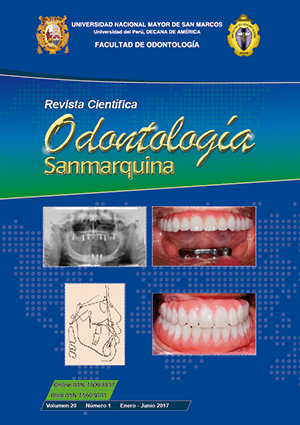In vitro study of the antibacterial activity of Erythroxylum coca extract on black-pigmented bacillus
DOI:
https://doi.org/10.15381/os.v20i1.13540Keywords:
Gram-negative anaerobic bacteria, Erythroxylon coca, Anti-bacterial agentsAbstract
Objective: To determine whether there is antibacterial activity of coca leaf extract (Erythroxylum coca), on black pigmented bacilli (BPB). Materials and method: Two tests were used: Diffusion Test in Agar and Dilution in liquid medium. The BPB strains were isolated from samples taken from periodontal pockets of patients with periodontal disease treated at the Faculty of Dentistry of the Mayor National University of San Marcos. The hydroalcoholic extract of coca leaf was obtained from the National Company of Coca (ENACO). Results: The first agar diffusion test indicated null sensitivity (-) for most of the concentrations evaluated, and limit sensitivity (sensitivity: +) for the concentrations of 12.5% and 100%. The results of the dilution sensitivity determined a minimum concentration of the extract capable of inhibiting the growth of this bacterium, 100% (minimum inhibitory concentration), and at the concentrations of 12.5% and 6.25% a repotentiation of the antibacterial effect of the extract. Conclusions: The hydroalcoholic extract of coca leaf, does present an antibacterial activity against BPB, at concentrations of 100% and 12.5%.Downloads
Downloads
Published
Issue
Section
License
Copyright (c) 2017 Carmen Enciso Deza, Donald Ramos Perfecto

This work is licensed under a Creative Commons Attribution-NonCommercial-ShareAlike 4.0 International License.
AUTHORS RETAIN THEIR RIGHTS:
a. Authors retain their trade mark rights and patent, and also on any process or procedure described in the article.
b. Authors retain their right to share, copy, distribute, perform and publicly communicate their article (eg, to place their article in an institutional repository or publish it in a book), with an acknowledgment of its initial publication in the Odontología Sanmarquina.
c. Authors retain theirs right to make a subsequent publication of their work, to use the article or any part thereof (eg a compilation of his papers, lecture notes, thesis, or a book), always indicating the source of publication (the originator of the work, journal, volume, number and date).






